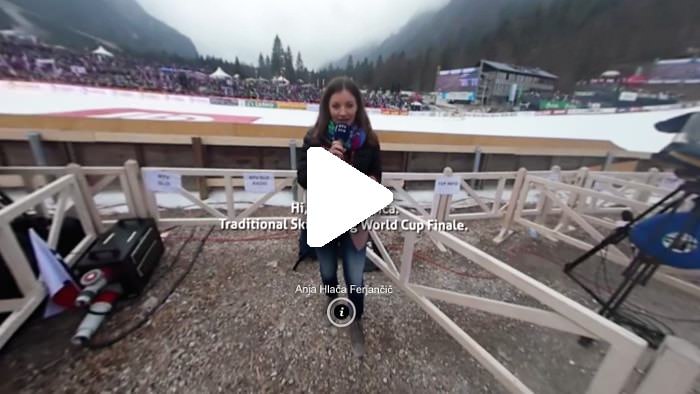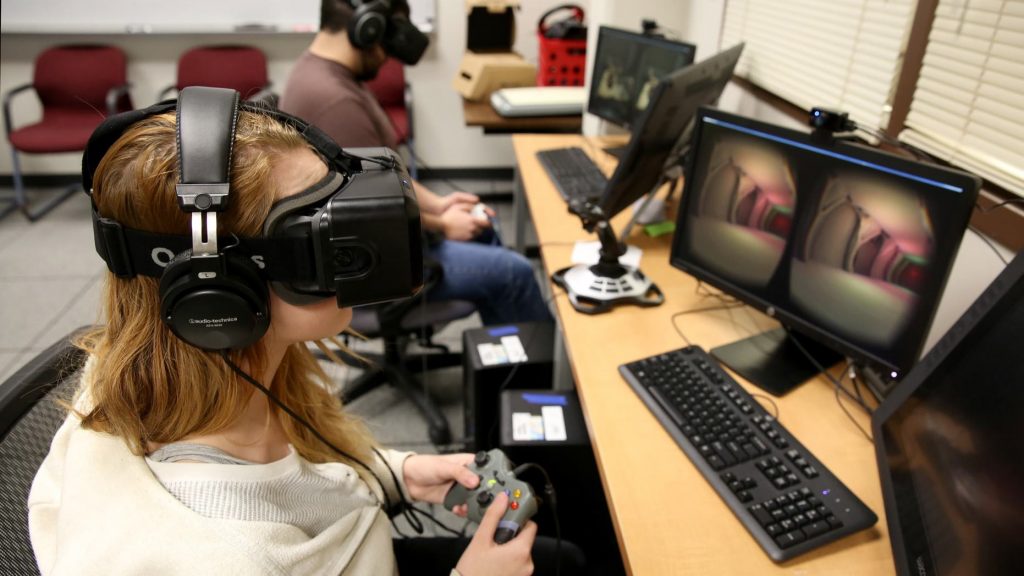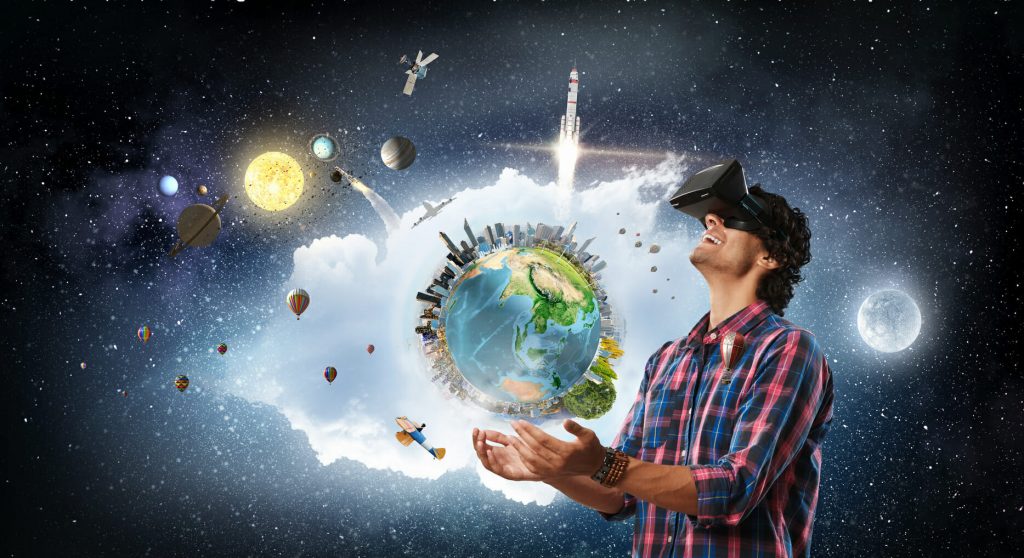VR Case Study Summary
- RTV Slovenia uses VR technology to improve engagement of their online content
- Prove that immersive news viewing holds more attention than traditional desktop viewing
- RTV recorded more than 5000 views over 48 hours with an average of 2 minutes of engagement time per session.
The Challenge
With information saturation, even the online news media organizations need to provide an engaging content to keep or grow their market share. RTV Slovenia needed to find a new way to win over millennial news readers. Virtual Reality was an opportunity to put people into news stories like never before.
It’s no secret that news media are dabbling in 360 journalism and cinematic virtual reality to tell better stories. Pioneers like Nonny de la Peña demonstrated the power of immersive storytelling back in 2015 with the CGI concept story: Hunger in LA. The piece invoked powerful emotions and responses from the viewers, even though the content used a simple low-resolution computer generated graphics.
That wasn’t the case. The point was that immersive storytelling can deliver a powerful message and provide more viewer engagement than any other type of digital media until now. The growth and adoption of 360˚ media, spherical camera sales and consumption of virtual reality shows us that the market is waking up to the possibilities of this ‘new’ digital media.
More immersive content brings more engagement from the viewers
Since 2015, all kinds of big brands have adopted this new medium for telling stories. The New York Times (NYT) was one of the first major providers to introduce VR storytelling for mass media consumption. NYT created their stories, packaged it into a mobile app and distribute them along with over a million Google Cardboards to their subscribers. The response was huge – not only from the viewers but from other brands as well.
In fact, The NYT VR app was downloaded over 500,000 times and 1.3 million Google Cardboard sets were distributed. It was their most quickly adopted app ever launched. NYT VR recorded over 1.5 million views with an average of 6 minutes engagement time per session.
The campaign claimed the mobile Grand Prix at Cannes Lions 2016. “It went beyond the initial wow factor to unlock levels of empathy and excitement no other medium could,” said Jury President, Malcolm Poynton, Global Chief Creative Officer, Cheil Worldwide.
Huffington Post followed suit with the acquisition of RYOT – a VR production studio. Since then Guardian, CNN and the BBC have all set up virtual reality departments with strong storytelling capabilities.
VIAR, Slovenian Startup of the Year 2017, have developed a solution for news media to become one of the VR storytellers as well. Their product, Viar360 is being used by some of the leading US journalistic schools such as University of Missouri, Penn State and Michigan State University. Viar360 is a publishing platform that allows news professionals create interactive virtual reality stories without any programming knowledge. The core benefits of Viar360 is the ability to rapidly create narratives in 360 and VR with interactive hotspots enabling branched storytelling backed up by powerful analytics.
For those who don’t have the same resources as the big media houses like NYT and CNN, Viar360 offers a white-label solution with the ability to add interactive elements.
In May 2017 they launched a partner project with RTV Slovenia – the Slovenian national broadcasting company. Like many news media organizations in Europe, RTV Slovenia wants to use virtual reality storytelling to enrich the experience of their viewers/ readers, The tools out there were too limited, complicated or unstable.
The producers, Matej Praprotnik (assistant director of radio strategies) and Matjaz Celic (Senior Motion Designer at RTV Slo) used the Viar360 platform to build the first interactive virtual reality news in Slovenia.
The project, virtual tour of Planica – an Alpine valley in northwestern Slovenia. Planica is most known as a ski resort. Their pride, a ski jumping hill “Letalnica bratov Gorisek” is the second biggest ski jumping hill in the world, surpassed only by Vikersund in Norway.
The objective of the project was to tell the story of Planica Ski Jumping Finale through the eyes of the reporters covering it by allowing the viewer to go behind the scenes to areas that are normally off-limits to the public. The feature created at the end of World Cup ski jumping season allowed the viewer of the story experience the story in either 360˚ panoramic mode or with virtual reality glasses (for a more immersive experience).
The story starts with an introduction welcoming message of Slovenian reporter – Anja Hlaca Ferjancic. She addresses the viewer to choose one of the paths they can take to continue the tour. They can choose to take a closer look of the ramp, tribunes stands or take a flight with the helicopter from Kranjska Gora to the Ponce valley.
Planica360 with hotspots that leads you to different areas.
The producers combined the 360˚ images and videos and connected them to provide an experience where the viewer chooses where to view. The images and videos alone are impressive enough but until now, there was no choice to interact with the story itself and make decisions on your own.
You can check the whole Planica 360 VR experience here.
What are the actual stats of the story and their results?
Planica 360:
Dates: Saturday 5/27/2017 – Sunday 5/28/2017
Total 360 media files used: 42
360˚ Video Files: 21
360˚ Image Files: 21
Total Image Media Views: 5640
Total Story Views: 5640
Total Number of HotSpots (Interactive Elements): 182
Total Number of Interaction in the Story: 14530
Total Story Session Logged: 4433
Total Story Session Time (s): 715685 = 198.8 Hours
Total Story Session Average Time(s): 161.44s
Total Story Bandwidth (MB): 665350.67 = 665.35 GB
In just 48 hours after publishing it on their online news site (Viar360 integrates perfectly):
- The story received 5640 views from 4433 sessions logged. This means that 27% of viewers returned to the story and watched it again.
- An average user interacted with the content 3.3x times.
Inside a broadcasting hut of Planica’s Ski Jumping location. Viewers have access to places where they wouldn’t have otherwise.
Praprotnik says that people who watched the story with VR headsets spent twice as much time in the story than other users who watched it on the web browser.
VR analytics involves the use of heat maps which tells you exactly where the users’ attention is the highest
Not only that, Celic and Praprotnik both did an extra experiment. When they showed the story to viewers in VR headsets they measured the time on how long they spend in the VR experience. After they were finished with the viewing they asked the participant about how long they thought they had watched it for.
On average the viewers perceived twice less time spent in the VR than the actual time. For instance, they said they watch the story for 5 minutes, while in reality, they spent more 10 minutes or more.
Since the analytics are counting total views from all devices we cannot entirely compare how much longer sessions are in the VR headset experiences and how many interactions more are done in VR mode than regular panorama mode. One thing is for certain, the engagement between the traditional video and 360˚ video is vast.
With the heat mapping tool, the producers have an insight on where the viewers focused their attention.
You can see exactly where people are looking with the use of heat maps
You can clearly see, that the viewers were following the ski jumper on the 360 video. This kind of insight shows you where to place hotspots for maximum engagement.
This has already been confirmed by Google study with Columbia the Sportswear company. Although the number of views is not necessarily higher, 360 stories increase the level of engagement and videos are more likely to be shared among peers.
“We haven’t had a clue on how to make the whole 360˚ story until we found the Viar360 platform. Viar360 is like WordPress for virtual reality – an easy-to-use tool for virtual reality for that allows anyone who wishes to tell stories in VR environment to do so. In the middle of the editing process, we found out that we actually had enough footage to create a short 360-degree documentary. Which we hadn’t even considered before!”, said Matej Praprotnik.
Viar360 bridges the gap between 360˚ video and virtual reality
In virtual reality, you have a choice to interact with the environment. While 360 media allows you to look around in the space, there’s no interactivity. Viar360 solves just that problem. It allows storytellers to create an interactive experience. A storyteller has the ability to add a layer of information on top of the 360˚ media or create transitions from one scene to another.
“There were a lot of questions in post-production on where to place hotspots and transitions points to have the story feel as natural as possible. We had to be careful with the selection and choosing the right graphical material. One of the main questions was if the viewer wants more freedom to choose or less. We haven’t looked at the analytics yet – and that’s where we can learn from the actual user’s feedback.
Praprotnik believes that virtual reality belongs in the journalism department. “There’s a great opportunity to use this medium in storytelling as well as an educational tool. Instead of classic storytelling, VR places the viewer at the heart of the experience and the environment around him. The viewer becomes part of the participant within the story. When you step into the Planica 360 story, the journalist Anja Hlaca Ferjancic talks directly to you.”
A new chapter in sport journalism
“This might be the next chapter in sports journalism and we might see it at the next Olympic Games. The technology is already being used but not many people have the chance to experience it yet. It’s a new medium and a new industry, which will first find its place in the entertainment sector before it finds a way in education and learning.





